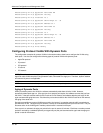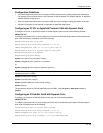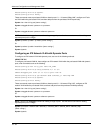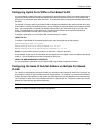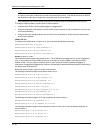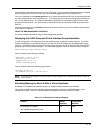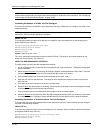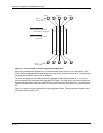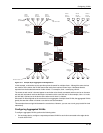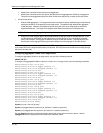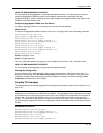
Advanced Configuration and Management Guide
NOTE: The device’s memory must be configured to contain at least the number of VLANs you specify for the
higher end of the range. For example, if you specify 2048 as the VLAN ID at the high end of the range, you first
must increase the memory allocation for VLANs to 2048 or higher. Additionally, on routing switches, if you allocate
additional memory for VLANs, you also need to allocate the same amount of memory for virtual interfaces, before
you configure the VLAN groups. This is true regardless of whether you use the virtual interface groups. The
memory allocation is required because the VLAN groups and virtual interface groups have a one-to-one mapping.
See
“Allocating Memory for More VLANs or Virtual Interfaces” on page 16-41.
If a VLAN within the range you specify is already configured, the CLI does not add the group but instead displays
an error message. In this case, create the group by specifying a valid contiguous range. Then add more VLANs
to the group after the CLI changes to the configuration level for the group. See the following example.
You can add and remove individual VLANs or VLAN ranges from at the VLAN group configuration level. For
example, if you want to add VLANs 1001 and 1002 to VLAN group 1 and remove VLANs 900 through 1000, enter
the following commands:
HP9300(config-vlan-group-1)# add-vlan 1001 to 1002
HP9300(config-vlan-group-1)# remove-vlan 900 to 1000
Syntax: add-vlan <vlan-id> [to <vlan-id>]
Syntax: remove-vlan <vlan-id> [to <vlan-id>]
USING THE WEB MANAGEMENT INTERFACE
You cannot configure this feature using the Web management interface.
Configuring a Virtual Interface Group
A virtual interface group allows you to associate the same IP sub-net interface with multiple port-based VLANs.
For example, if you associate a virtual interface group with a VLAN group, all the VLANs in the group have the IP
interface of the virtual interface group.
To configure a virtual interface group, use the following CLI method.
NOTE: When you configure a virtual interface group, all members of the group have the same IP sub-net
address. This feature is useful in collocation environments where the device has many IP addresses and you
want to conserve the IP address space.
USING THE CLI
To configure a virtual interface group, enter commands such as the following:
HP9300(config)# vlan-group 1
HP9300(config-vlan-group-1)# group-router-interface
HP9300(config-vlan-group-1)# exit
HP9300(config)# interface group-ve 1
HP9300(config-vif-group-1)# ip address 10.10.10.1/24
These commands enable VLAN group 1 to have a group virtual interface, then configure virtual interface group 1.
The software always associates a virtual interface group only with the VLAN group that has the same ID. In this
example, the VLAN group ID is 1, so the corresponding virtual interface group also must have ID 1.
Syntax: group-router-interface
Syntax: interface group-ve <num>
Syntax: [no] ip address <ip-addr> <ip-mask> [secondary]
or
Syntax: [no] ip address <ip-addr>/<mask-bits> [secondary]
The router-interface-group command enables a VLAN group to use a virtual interface group. Enter this
command at the configuration level for the VLAN group. This command configures the VLAN group to use the
16 - 40



